Some graphics are unable to be reproduced in the HTML view of this publication. Please refer to the PDF for the optimal experience.
Welcome to the Hive!
This book was designed to introduce you to one of the most social insects on the planet, the honey bee. Honey bees do more than make delicious honey for us to eat; so come discover for yourself! You don’t have to be a beekeeper to participate. You just need to be curious about honey bees. Follow the “Beeline” through each section on your own or with the help of your leader. Some activities you can do by yourself, but most were made for you to participate with a group of friends. You will learn a lot of new vocabulary from the world of honey bees. These words are in bold font when they are first introduced. If in later sections you forget a definition, you can look back to previous sections or use the glossary at the end of this chapter. When you get to the end of the “beeline,” hopefully you will have learned new and interesting facts about the honey bee.

Credit: Michael Hammond, used with permission
Follow the Beeline!
Just like honey bees follow a beeline from the hive straight to the flower, you will look for these symbols to lead you straight through the activities in this project book to help you learn more about honey bees.
What’s the Buzz?
To get things going with each section, a brief introduction to the topic will be given. New vocabulary words will be in bold font. When you see this buzzing bee, take a few minutes and read this section on your own or with your leader so you will be ready to complete the activities in the section.
Foraging for Nectar
Just as honey bees must leave their hive to go out and search for nectar and pollen, this bee signals there is an activity to get you up and doing something. When you see this bee, it is your chance to explore the world of honey bees, either with a learning experience or another fun hands-on activity. Some you can do on your own. For others, you will need the help of friends.
Return to the Hive
Once honey bees find nectar or pollen, they bring it back to the hive and share it with the colony. When you see this beehive, it is time for you to return and think about what you have learned. Reflect on your experience by answering some thoughtful questions.
Taste the Honey!
Bees do not make honey for nothing—they eat it! Tasting the honey is how bees enjoy the fruits of all their hard work. When you see this pot of honey, this is your chance to see the fruit of your efforts. Take a few minutes to ponder these questions and see what you have learned about honey bees and how you can use the information in your own life.
The Bee’s Knees
When something is really neat or interesting, people will say it is “the bee’s knees.” These sidebars offer more information and other interesting facts about honey bees and the things they do.
Pollen Patties
Many beekeepers will give their bees pollen patties as a food supplement to help strengthen the colony. This bee signals closing activities that can be fun and offer deeper learning to strengthen your understanding about a topic. You are not required to complete these activities; they are optional.
Chapter 1.1 Meet the Honey Bees!

Credit: Mike Bentley, UF/IFAS
What’s the Buzz?
The scientific name for honey bee is Apis mellifera, meaning “bee that bears honey.” Many people hear the words “honey bee” and think of a flying insect with a stinger and black and yellow stripes that buzzes around. While this does describe the honey bee, it also describes thousands of other insects that mimic, or copy, the looks of a honey bee. This is an easy mistake to make with nearly 25,000 different species of bees in the world and over 4,000 just in North America!

Credit: Mike Bentley, UF/IFAS
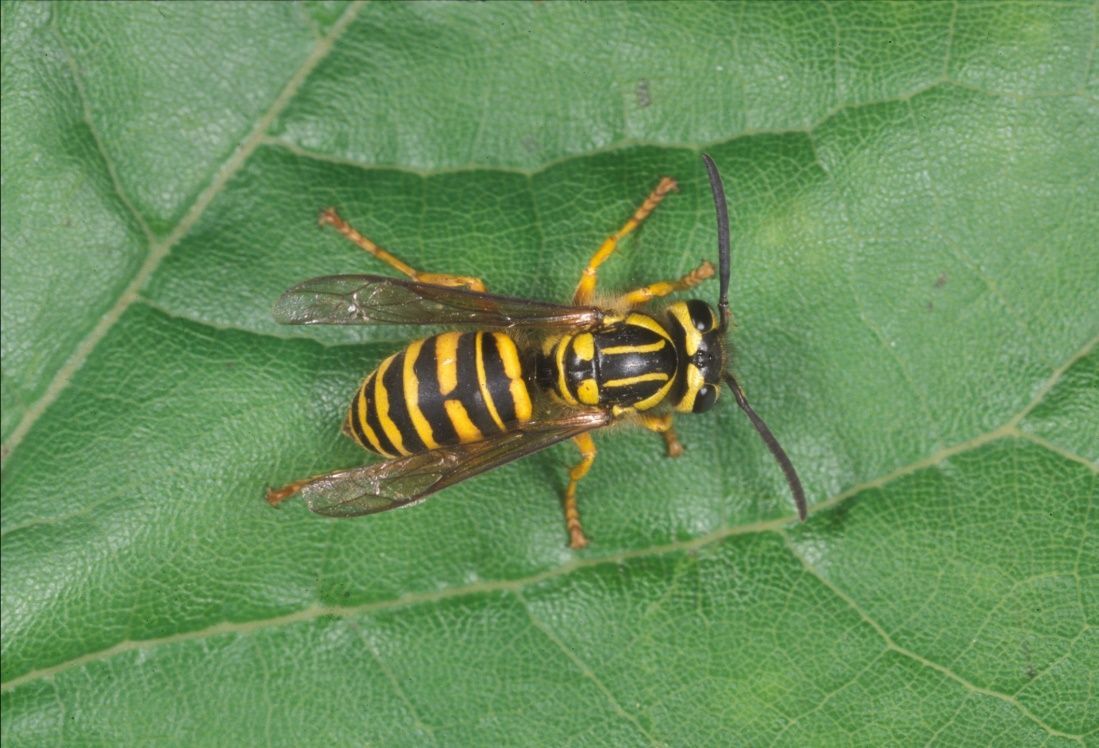
Credit: Lyle Buss, UF/IFAS
Compare how similar the honey bee and wasp look (Figures 2 and 3). Yet both can easily be recognized by the ways they act, the food they eat, and the way they look. Honey bees tend to build their nests in an enclosed cavity, such as a hole in a tree trunk. Wasps will build a nest out in the open on a tree branch. Honey bees are herbivores, insects or animals that eat plant material such as pollen and nectar. Wasps are omnivores, insects or animals that eat other insects in addition to plant material. Honey bees tend to have more hairs on their bodies and look fuzzy compared to a wasp’s shiny, often hairless body. Last of all, while both insects have similar body form and shape, wasps have a much thinner waist than honey bees do. Reading this next section will help us learn the basic body parts of a honey bee, which will help us in later sections to understand how bees work individually and together as a colony.
Foraging for Nectar
Activity #1—What Do You Know
In the first box below, draw what you think a honey bee looks like before continuing to the next activity. “Bee” specific! Then come back after the activity and draw another picture in the second box showing what you have learned about the honey bee’s body.
Before:
After:
Activity #2—Honey Bee Body Matching
Now learn about the body arrangement of the honey bee by completing the following matching activities below. Look carefully at each picture and labels to help you figure out the meaning of each word and write it on the line next to the correct description. Once you finish this activity, do not forget to go back to Activity #1 and make your second drawing to see if you have learned anything new about honey bee bodies.
The Body

Credit: Mike Bentley, UF/IFAS
Match each body section shown above with the correct description below.
- This body section is known as the center for locomotion, or movement. It is the location of the muscles and body parts that allow the honey bee to move and fly.
- This body section is the location of most of the honey bee’s major organs and stinger.
- This body section is known as the honey bee’s “sensory headquarters” and is the location of the different body parts used to sense and gather information.
The Head

Credit: Mike Bentley, UF/IFAS

Credit: Mike Bentley, UF/IFAS
Match each part of the head shown above with the correct description below.
- The_______________________ is the honey bee mouthpart that acts like teeth and jaws. There are two of these on the head.
- An_______________________ can pick up smells and vibrations to gather information about a honey bee’s surroundings. There are two of these on the head as well.
- There are two _______________________, or larger eyes, located on each side of the honey bee's head.
- There are three______________________, or simple eyes, arranged in a triangle on top of the honey bee’s head between the compound eyes.
- The_______________________ is a long, soft, straw-like tongue honey bees use for drinking or sucking nectar and water.
The Legs

Credit: Mike Bentley, UF/IFAS

Credit: Mike Bentley, UF/IFAS
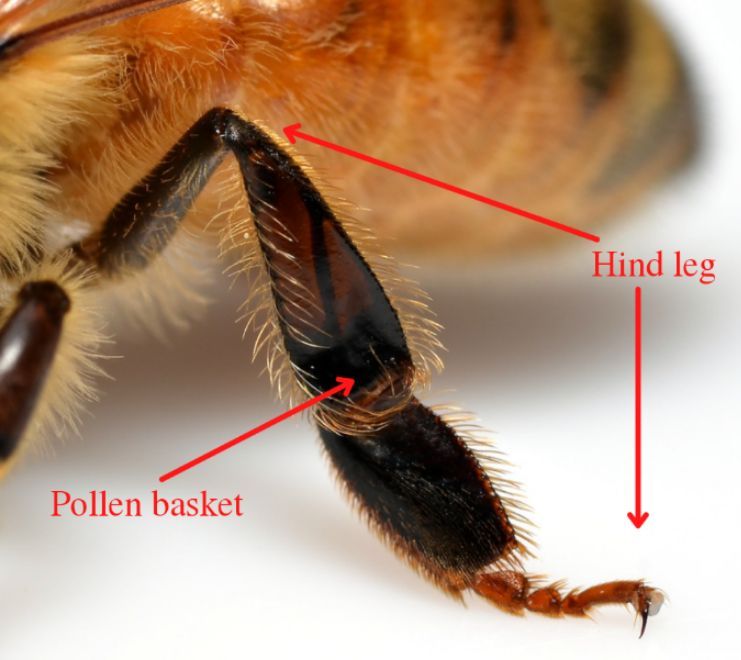
Credit: Mike Bentley, UF/IFAS
Match each specialized leg part shown above with the correct description below.
- The________________, also known as the corbicula, is an area curved inward on the hind leg of a honey bee that holds pollen to carry back to the nest.
- The _______________is a stiff, sharp, finger-like projection on the midleg used to remove pollen from the honey bee’s corbicula.
- The______________________ is a cleaning tool located on the foreleg that helps the honey bee remove debris, or litter, out of its antennae.
Special Features

Credit: Mike Bentley, UF/IFAS

Credit: Mike Bentley, UF/IFAS

Credit: Mike Bentley, UF/IFAS
Match each specialized body part shown above with the correct description below.
- A__________________ is a long, pointed structure found at the end of the honey bee’s abdomen. It is used to inject venom, or poison, into its victims.
- The__________________ is the smaller, bottom wing located on the honey bee’s thorax.
- ___________________ are tiny hooks in a row along the top edge of the hindwing (part A) that connect it to the bottom edge of the forewing (part B).
- The__________________ is the larger, top wing located on the honey bee’s thorax.
- _______________________ are tiny openings located along the underside of a honey bee’s abdomen. This is where beeswax is made.
The Bee’s Knees

Credit: Mike Bentley, UF/IFAS
Only female honey bees in the colony have a stinger. It is a modified ovipositor, which is a body part that is used to lay eggs. The ovipositor has been adapted, or changed, to be used for defense and to sting. Tiny hooklike barbs line the stinger and cause it to get stuck in the victim when the worker bee uses its stinger for self-defense. As the worker bee flies away, the stinger is pulled from its body along with the venom sac, which stores the bee’s venom. Even after the bee has flown away, the stinger continues to pump venom into the victim using muscles and nerves connected to the venom sac. So, if you are ever stung, make sure to remove the stinger immediately.
Return to the Hive

Credit: Mike Bentley, UF/IFAS
- Which mouth part does the honey bee use to drink nectar from a flower?
- Which honey bee body parts come in pairs? How many eyes do they have in total?
- Which body parts are necessary for the honey bee’s locomotion or movement?
- Why are honey bees often confused with other buzzing insects? What are some ways you can tell the difference between honey bees and other similar-looking insects?
Taste the Honey

Credit: Obaba, iStock, Getty Images
1. How is your body similar to that of a honey bee, and how is it different?
2. What parts on your body are used for sensing the world around you? (Think of your five senses.)
3. What would it be like if one of these body parts did not work? (Choose one and explain.)
Pollen Patties

Credit: Mike Bentley, UF/IFAS
Now that you can correctly identify the parts of a honey bee, use your understanding to create a representation of a honey bee. Gather craft items like pom-poms, feathers, pipe cleaners, paper, toothpicks, etc. from around your home. You could also use materials found outside in nature like leaves, pinecones, pine needles, twigs, bark, flowers, acorns, etc. Choose items that will represent the specific body parts that have been discussed and let your imagination take over to build your honey bee. With the help of an adult, use a hot glue gun to glue your honey bee together. After you have built your honey bee, explain to someone else why you chose specific items to represent the honey bee body parts.
Chapter 1.2 What Do Honey Bees See?

Credit: Mike Bentley, UF/IFAS
What’s the Buzz?
At a quick glance, it looks as though honey bees have only two eyes, but a closer look will reveal five eyes! The two larger eyes located on each side of the head are called compound eyes. Compound eyes are made up of 6,900 smaller lenses, called facets, that give the honey bee a mosaic-like view of the world. This means they see the same image that we see, but in many smaller pieces like in a mosaic tile picture.

Credit: Bluberries, iStock, Getty Images
The remaining three eyes, called ocelli, are simple eyes with a single lens. They are arranged in a triangle on top of the head between the compound eyes. Ocelli allow honey bees to notice the presence of and changes in light, which help honey bees react to their environment. Visible light, or the kind of light that humans can see, is made up of all the colors of the rainbow (Figure 3). Honey bees can see all these colors, except red. In addition to visible light, honey bees can see ultraviolet (UV) light, which is the light from the sun that causes sunburns. These eye differences allow honey bees to easily find and focus on the center of flowers where the pollen and nectar are located.
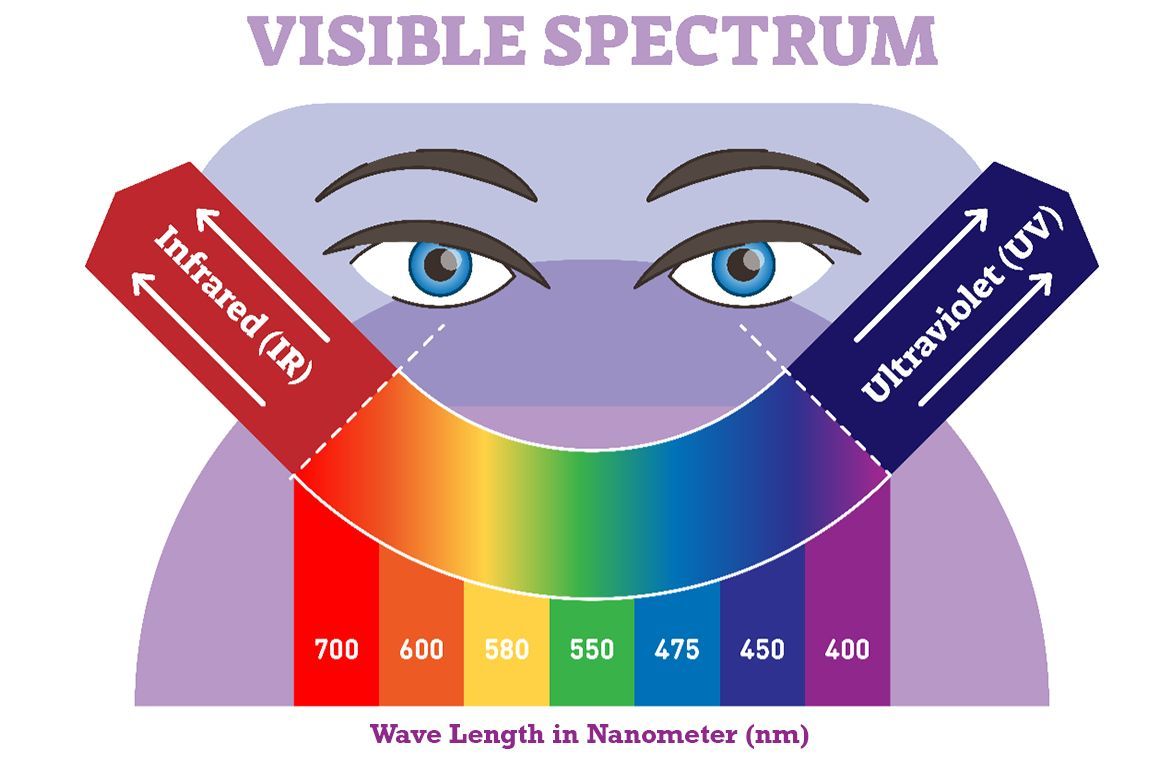
Credit: VectorMine, iStock, Getty Images, revisions by Randy Fernandez, UF/IFAS Entomology and Nematology
The Bee’s Knees
On the left is what humans see when looking at a flower. On the right is what a foraging worker honey bee sees when looking at the same flower. Amazing! Look at that target! The honey bee's ability to see UV light allows them to see different patterns on the flowers that humans cannot see. This ability helps them know right where to go for the pollen and nectar.

Credit: Dave Kennard, CC BY-SA 3.0
Foraging for Nectar
Activity #1—Bee-noculars
In this activity you will make a gadget, or tool, that tries to give you a glimpse of what it might be like to see the world through a mosaic lens. You can do this activity on your own or with a group of friends.
Step 1. Collect the following materials for this activity:
- paper cup
- sharp pencil
- green permanent marker
- clear packing tape
- scissors
- black tempera paint
- paintbrush

Credit: Megan Hammond, UF/IFAS Honey Bee Research and Extension Laboratory.
Step 2. Using black paint, coat the entire inside of a paper cup. While you are waiting for the paint to dry, try working on the crossword puzzle activity that follows this one.

Credit: Megan Hammond, UF/IFAS Honey Bee Research and Extension Laboratory.
Step 3. Once the paint has completely dried, flip the cup over and use the sharpened pencil to poke holes in the bottom of the cup until it is completely covered.

Credit: Megan Hammond, UF/IFAS Honey Bee Research and Extension Laboratory.
Step 4. Use clear packing tape to cover all the holes on the outside of the bottom of the cup.

Credit: Megan Hammond, UF/IFAS Honey Bee Research and Extension Laboratory.
Step 5. Using the green permanent marker, color all the tape on the bottom to cover the holes with green.

Credit: Megan Hammond, UF/IFAS Honey Bee Research and Extension Laboratory.
Step 6. When finished, hold the open part of the cup up to your eye and look out of the other end. Go outside and look at flowers, trees, buildings, and cars first without the Bee-noculars and then with them. Notice any difference?
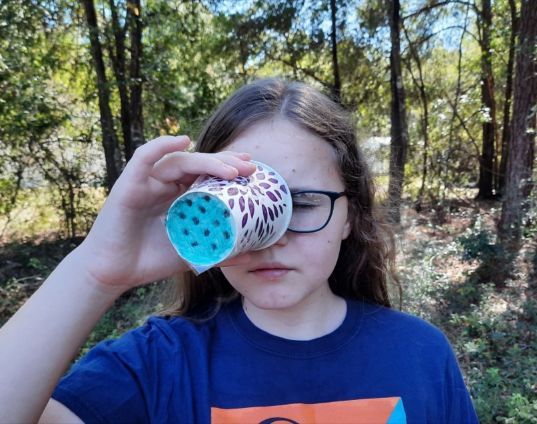
Credit: Megan Hammond, UF/IFAS Honey Bee Research and Extension Laboratory
Activity #2—Honey Bee Vision Crossword Puzzle
While honey bees may not see things as we do, their unique vision makes it easier for them to find the center of flowers to locate pollen and nectar resources. Now, use your vision and new knowledge to solve this crossword puzzle. This is a great activity to do while you are waiting for the paint in your cups to dry in the activity #1.

Credit: undefined
Down
1. These eyes come in a group of three and sense changes in light.
2. This is the light from the sun that we cannot see and that causes sunburns.
3. This is the source of all light.
4. This is made up of seven colors and stretches across the sky.
5. There are 6,900 of these found in a compound eye.
Across
6. This large pair of eyes gives insects a mosaic view of the world.
7. You have a pair of these that you use to see.
8. Another name for lenses in the compound eye.
9. The opposite of dark.
10. Another word for your sense of sight.
11. This is like looking at a picture but in lots of smaller pieces.
12. The opposite of invisible.
Return to the Hive

Credit: UF/IFAS Communications
- How does a honey bee’s vision differ from how we see the world and light?
- How was your vision changed by the Bee-noculars?
- Why is this different kind of vision important for honey bees?
Taste the Honey

Credit: UF/IFAS Honey Bee Research and Extension Laboratory
- Would the kind of vision that bees have be useful for humans? Why or why not?
- What are some things that we use to correct or magnify our vision to give us a clearer view of things that are near? Or far away? Or that are very small?
Pollen Patties

Credit: Sakurra, iStock, Getty Images
Sit in front of a mirror and look closely at the pupils, the black circles, in your eyes. Pay close attention to the size of your pupils. Now close your eyes and gently cover them with your hands for 20 seconds. As soon as you open your eyes, look closely at your pupils again in the mirror. They may be dilated, or larger than before and then quickly contract, or shrink back down. If you do not have a mirror, you can do this with a friend and look at each other's pupils before and after closing your eyes. Your pupils, just like the ocelli on a honey bees head, respond to changes in light. Discuss with your group why you think your pupils get larger when you cover your eyes and smaller when you open your eyes. Do you think it has anything to do with the amount of light?
Chapter 1.3 The Honey Bee Life Cycle

Credit: UF/IFAS Honey Bee Research and Extension Laboratory
What’s the Buzz?
Just like many other insects, honey bees go through complete metamorphosis, which means change (meta) in shape (morph). Their bodies will completely change from the time they are hatched until they become adults. The members of a honey bee colony are divided into three castes, or groups: workers, queens, and drones. A bee’s caste and gender will be determined by whether the queen fertilizes the egg and what the newly hatched larva is fed. If the egg is fertilized, it will become a female (queen or worker). If the egg is not fertilized, it will become a male (drone). A queen can grow into an adult in 16 days. Her sisters, the workers, can take up to 21 days to emerge as an adult. Drones have a slightly longer growth period of 24 days because they are larger in size than the workers or queen.

Credit: Mary Bammer, UF/IFAS Honey Bee Research and Extension Laboratory
Egg Phase
There are four phases of metamorphosis through which honey bees pass (Figure 2). First, an egg that looks like a small grain of rice is laid by the queen in its own wax cell, one of the chambers shaped like a hexagon, in the comb. A healthy queen will lay only one egg per cell. The egg is in an upright position at the bottom of the cell (Figure 3).

Credit: UF/IFAS Honey Bee Research and Extension Laboratory
Larval Phase
After a few days, a wormlike larvae hatches from the egg (Figure 4). Adult workers feed all larvae (plural of larva) royal jelly for the first three days of life. Royal jelly is a thick, milky-white liquid that is made by the worker bees. The younger larvae are sometimes called “C-shaped larvae” or “milky brood” because they look like the letter “C” swimming in royal jelly that looks like milk at the bottom of the cell. After three days, larvae that will become workers or drones are switched to a diet of “brood food” containing pollen and honey. Larvae that become queens, however, are fed only royal jelly their entire lives. Adult workers will feed each larva 1,000–2,000 times before the end of the larval phase.

Credit: Mike Bentley, UF/IFAS
Pupal Phase
At this point, workers will cover the cell with a wax capping, or lid. The larva will then spin a silk cocoon around itself. In this life stage, the larva changes into a soft, white version of an adult honey bee with purple eyes, called pupa. The capped growing “baby bees” or pupae (plural of pupa) are still referred to as brood.

Credit: Mike Bentley, UF/IFAS
Adult Phase
After a few more days, the honey bee’s body starts to sclerotize, or harden, and evolve into a full-grown adult. Once fully developed, the honey bee will chew its way out of the cell and be ready to start working in the hive.

Credit: UF/IFAS Honey Bee Research and Extension Laboratory
Foraging for Nectar
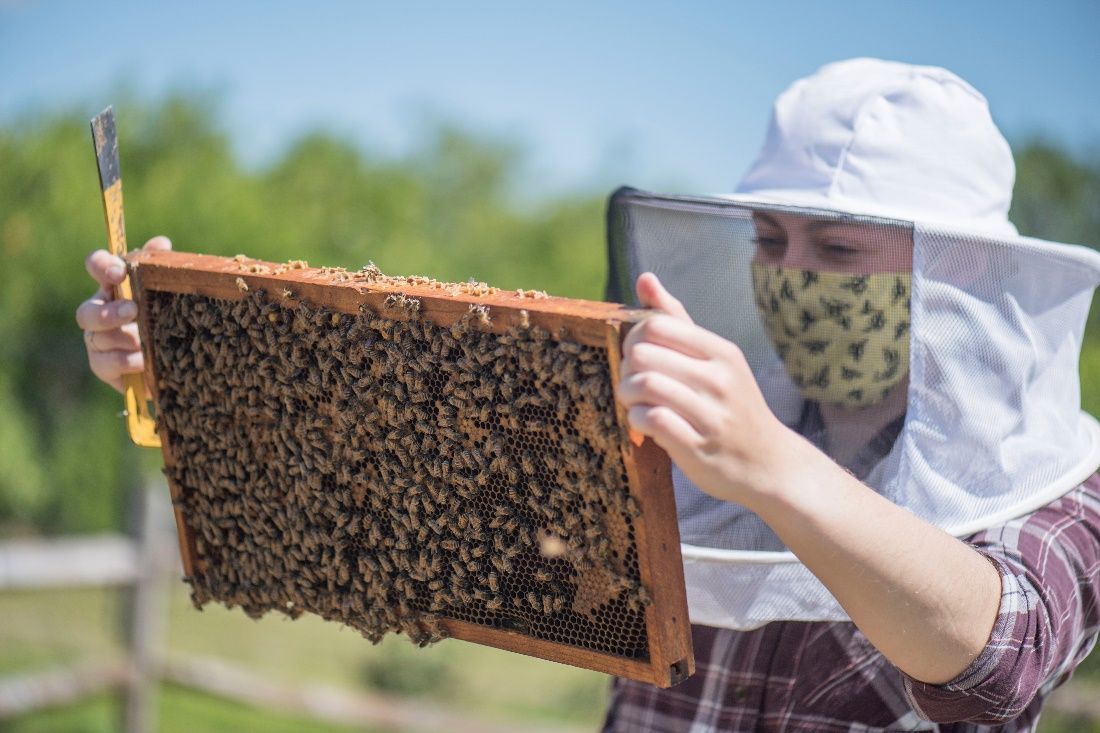
Credit: Bori Bennett, UF/IFAS Honey Bee Research and Extension Laboratory
Activity #1—Pasta Life Cycle Craft
One sure sign of a healthy colony is being able to see all four developmental stages of the honey bee in the hive. If you can see eggs, larvae, capped brood, and worker bees, you can assume your queen is strong and doing her job. When beekeepers inspect their hives, they remove one frame at a time to look for eggs, larvae, and brood. They also inspect for honey and pollen. As you make this craft with rice and different shapes of pasta, be sure your frame represents how a healthy colony should look.
Step 1. Gather the following materials for the craft:
- cardboard 18-count egg cartons (one for each person)
- rice
- elbow macaroni noodles
- spiral noodles
- bowtie noodles
- liquid glue
- tempera paint and brushes
- markers
- scissors
Step 2. Cut off the egg carton lid and front flap. The carton will represent a honey bee frame with wax brood cells.

Credit: Megan Hammond, UF/IFAS Honey Bee Research and Extension Laboratory.
Step 3. Use paint or markers to color the inside of the top row and side cells of the frame to represent honey and pollen.

Credit: Megan Hammond, UF/IFAS Honey Bee Research and Extension Laboratory.
Step 4. Starting on the left side, glue a single piece of rice in each of two open cells to represent the “eggs.”

Credit: Megan Hammond, UF/IFAS Honey Bee Research and Extension Laboratory.
Step 5. Glue a single macaroni noodle in each of two open cells to represent the “C-shaped larva.”

Credit: Megan Hammond, UF/IFAS Honey Bee Research and Extension Laboratory.
Step 6. Glue a single spiral noodle in each of two open cells to represent the pupae.

Credit: Megan Hammond, UF/IFAS Honey Bee Research and Extension Laboratory.
Step 7. Glue a single bowtie noodle in each of the two remaining cells to represent the full-grown adult honey bee. Allow your project to dry.

Credit: Megan Hammond, UF/IFAS Honey Bee Research and Extension Laboratory.
Step 8. Review the growth stages of the honey bee from egg to adult and compare their shapes to rice and the different noodles that you used. Discuss how being able to see pollen, honey, and all four stages of complete metamorphosis on your frame is a sign of a healthy honey bee colony.

Credit: Megan Hammond, UF/IFAS Honey Bee Research and Extension Laboratory.
Activity #2—Honey Bee Life Cycle Word Search
Find the words from the list below in the crossword puzzle. Words can be found across, down, and diagonal.
Word Bank
- Adult
- Brood
- Caste
- Cell
- Cocoon
- Colony
- Complete
- Development
- Drone
- Egg
- Hive
- Honey
- Larva
- Life Cycle
- Metamorphosis
- Nectar
- Pollen
- Pupa
- Queen
- Royal Jelly
- Sclerotize
- Worker
Return to the Hive
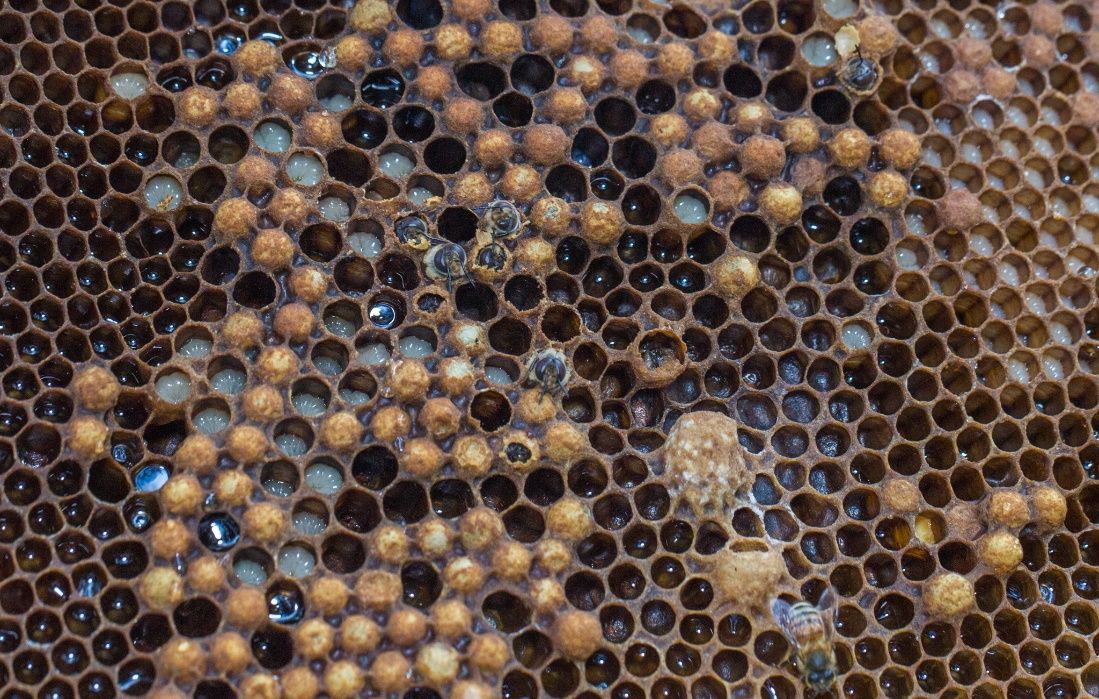
Credit: Geena Hill, UF/IFAS Honey Bee Research and Extension Laboratory
- Why are some larvae fed different foods than other larvae?
- Why do the larvae eat so much food at this stage of growth?
- What is happening to the honey bee’s body during the pupal stage?
- When has a honey bee completed metamorphosis?
Taste the Honey
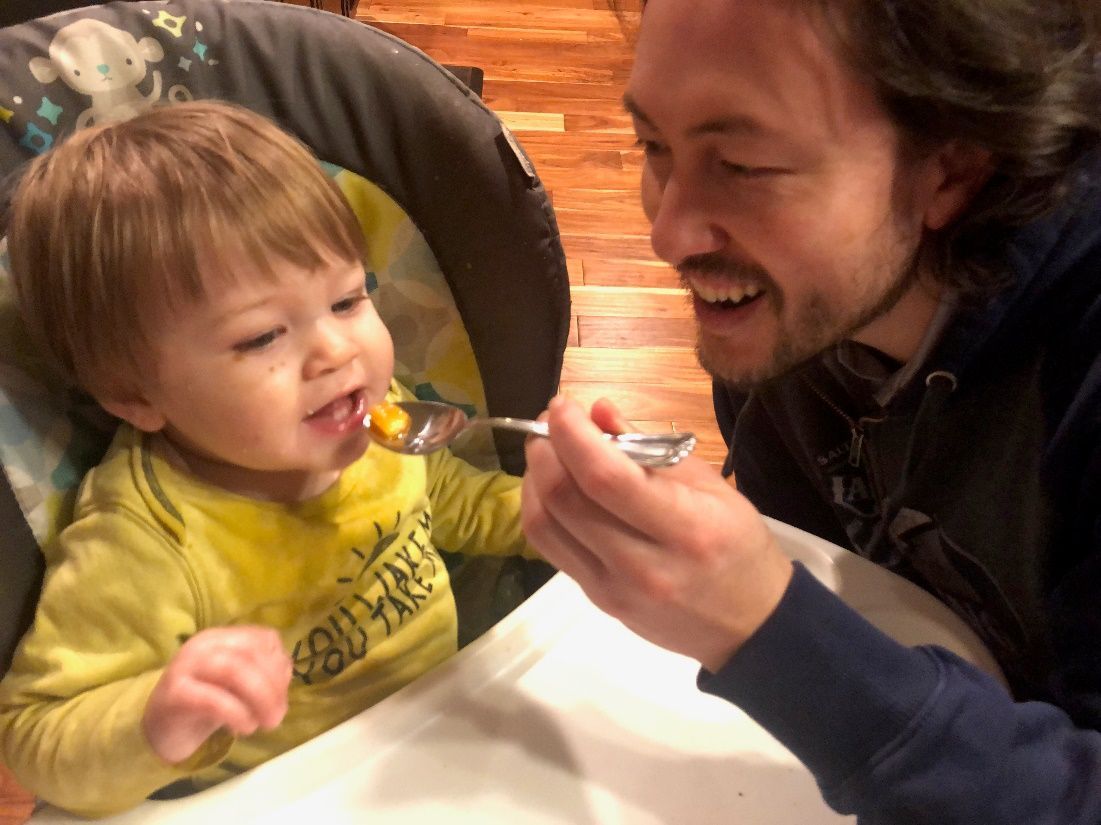
Credit: Megan Hammond, UF/IFAS Honey Bee Research and Extension Laboratory
- Why are human babies fed different foods than adults eat?
- Do humans experience metamorphosis? How do you know?
The Bee’s Knees

Credit: UF/IFAS Photos
Honey bees are the only insect that produce a food eaten by humans. That food is honey, of course! Honey can come in assorted colors and have different flavors. The color and flavor of the honey depends on the type of flower the honey bee got the nectar from. For example, if a honey bee is collecting nectar from an orange tree, the honey will have a slight orange flavor.

Credit: Mike Bentley, UF/IFAS
A honey bee’s wings beat incredibly fast, about 200 times per second! This is how they make their distinctive buzzing sound. A honey bee can fly up to five miles away from its hive at a speed of 15 miles per hour. A colony of bees will fly 90,000 miles, which is the same as circling the earth three times, just to collect 2 pounds of honey!
Pollen Patties

Credit: Tyler Jones, UF/IFAS Communications
In the spring or summer, take a walk with a parent or guardian and try to find a caterpillar in the grass or weeds. What phase of complete metamorphosis is it? What phase was it in before? After correctly identifying the caterpillar, with the help of an adult, capture one and collect some of the plant it was eating. If you cannot tell what kind of caterpillar it is, be careful not to touch it, because it may be venomous. Keep it in a jar with air holes in the lid or a butterfly cage. Continue to add fresh grass or leaves each day until it goes into the pupal phase. Then wait and see what it looks like when it emerges and comes out of the cocoon. What phase is it in now? Make sure to release it back into the wild when you are done.
Chapter 1.4 Three Kinds of Honey Bees

Credit: Mike Bentley, UF/IFAS
What’s the Buzz?
There is an important difference to understand between the words “hive” and “colony.” The hive is the artificial structure that serves as a home for a honey bee colony. The colony is the group of closely related bees that live and work together. A hive is like a house, while a colony is a family living inside the house. Honey bees have lived in the wild much longer than humans have made hives for them. For millions of years, honey bees have successfully searched for and found homes for themselves in places such as inside a hollow tree or other similar space. Beekeepers have made many different types of hives as useful homes to make it easier to keep honey bee colonies and harvest their honey. Langstroth hives (Figure 2) can have eight to ten frames and are the most common type of hive used today.
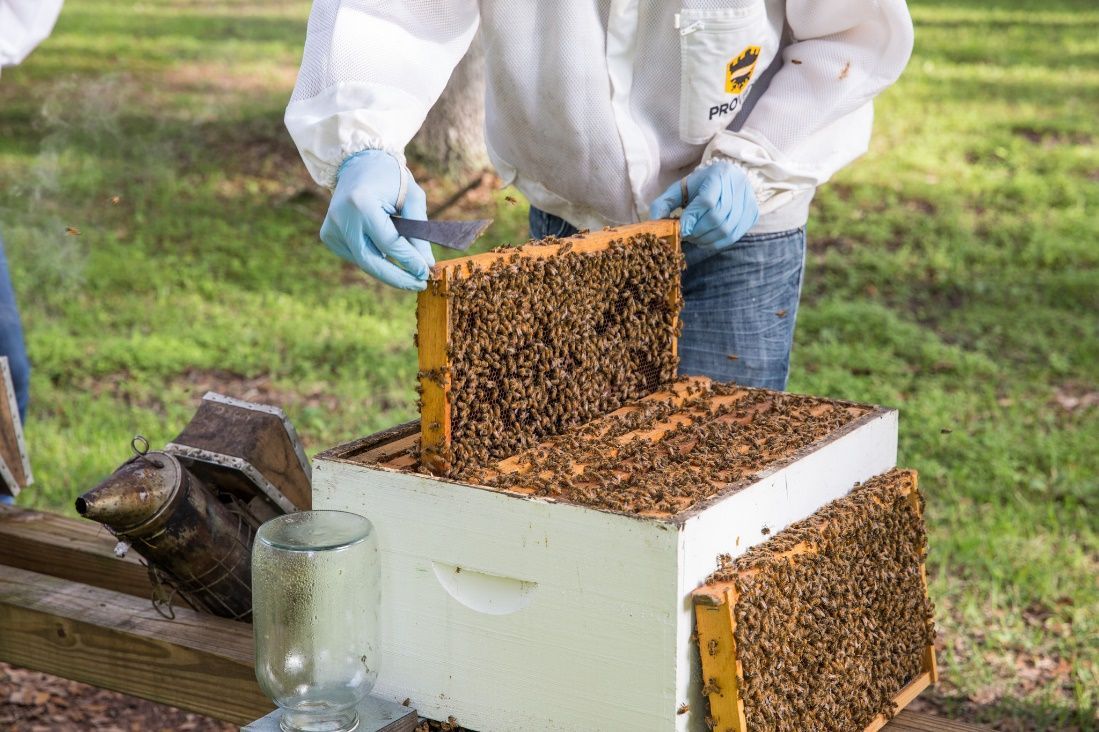
Credit: Geena Hill, UF/IFAS Honey Bee Research and Extension Laboratory
An introduction to the honey bee colony members will show how their different roles are important in how the colony works together. Female honey bees in a colony can be workers or queens. The drones are the male honey bees of the colony.

Credit: Mike Bentley, UF/IFAS
Worker Honey Bees
- Are female.
- Take 21 days to grow and develop from egg to adult.
- Have a lifespan of 6 weeks to 6 months.
- Have a stinger.
- Perform the daily tasks in and outside the hive.
- Cycle through different tasks in the hive depending on their age.
- Are the honey bees we see buzzing from flower to flower.
- Are the smallest honey bee in the hive.
- Make up the largest group of honey bees in the hive.

Credit: Emily Helton, UF/IFAS Honey Bee Research and Extension Laboratory

Credit: Mike Bentley, UF/IFAS
Queen Honey Bee:
- Is female.
- Is usually the only queen in the entire colony.
- Takes 16 days to grow and develop from egg to adult.
- Has a lifespan of 2–3 years.
- Lays eggs, up to 2,000 in one day!
- Produces pheromones that tell the workers she is alive and attract drones when she is ready to mate.
- Is surrounded by a circle of worker bees who feed her, clean her, and remove her waste.
- Can be recognized by her abdomen, which is longer than that of the workers or drones.
- Is sometimes marked by a beekeeper with a dot of colored paint on her thorax. This is so she is more easily found in a crowd of 20,000 or more other honey bees.
The Bee’s Knees

Credit: Mike Bentley, UF/IFAS
The queen gives off her unique pheromone or scent called the queen mandibular pheromone. This signals to the workers that she is alive and well. When she gets older or dies, her pheromone scent weakens in the hive. Her workers recognize that they need a new queen. The colony can only survive a brief time without a queen. If a colony believes they are queenless, they will build a “queen cup,” a special bigger cell over the existing cell of a very young female larva, and continue to feed her royal jelly for the rest of her development. This will cause her to grow and become a queen instead of a worker. When this happens, a colony is said to have requeened itself.

Credit: Mike Bentley, UF/IFAS
Drones:
- Are male.
- Take 24 days to develop from egg to adult.
- Have a lifespan of 2–4 months.
- Do not have a stinger.
- Are hatched mostly during spring and early summer months when there is plenty of food.
- Are larger and have more rounded abdomens than do worker bees or the queen.
- Have very large eyes so they can see the queen during flight.
- Mate with the queen.
- Are thrown out of the hive in the fall and not allowed back. This is done to save the honey supply for the rest of the colony to have enough food for the winter.
Foraging for Nectar

Credit: UF/IFAS Honey Bee Research and Extension Laboratory
Activity #1—Honey Bee Colony Sorting
Each member in the colony has a key role to play to keep everything in the hive working smoothly. Each member has special adaptations or changes to their bodies that help them do their specific work. In the chart below, you will decide which characteristics or traits are describing which type of honey bee: workers, queens, or drones. Place an X under the column of the bee that matches the description. (Hints: Some information may have been mentioned in previous chapters. Some characteristics are for more than one type of bee.)

Credit: Mike Bentley, UF/IFAS.
Activity #2—Finding the Queen
Beekeepers will look for the queen on each frame when checking their hives. See if you can spot the queen on the frames in the pictures below. Think of ways you can tell her apart from all the other bees. Do you remember? Look back at the descriptions of the queen if you have any trouble finding her in the pictures. When you find the queen, use a brightly colored marker to circle her in each picture.


Credit:

Credit:
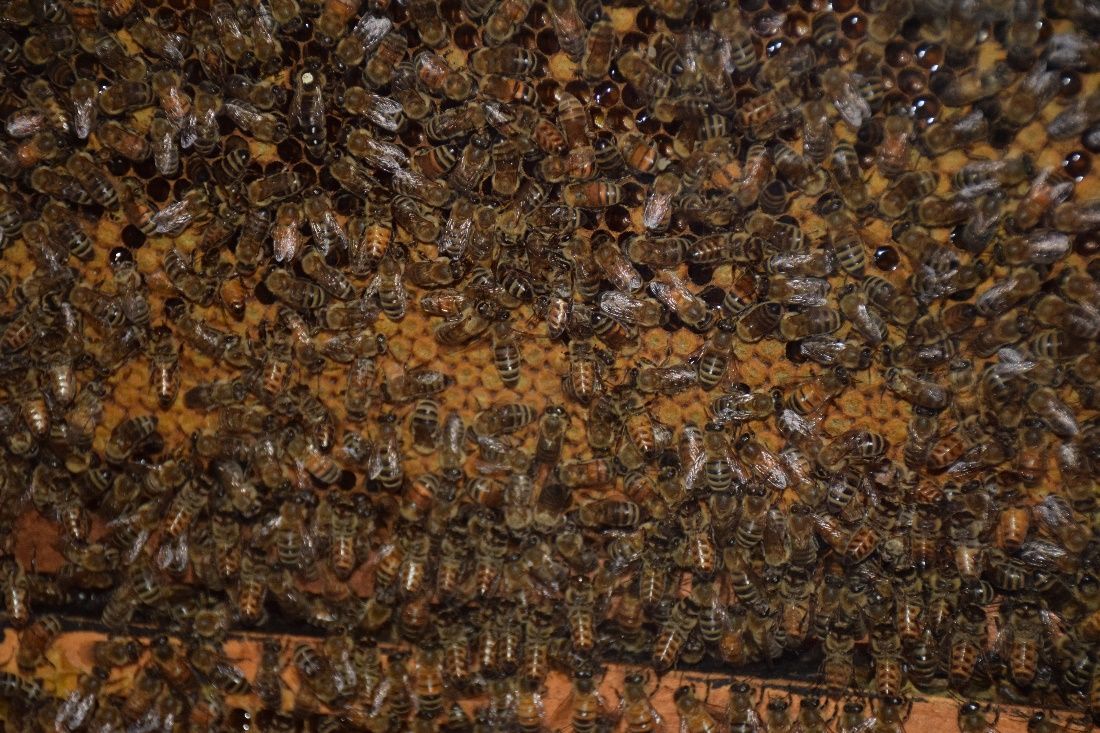
Credit:
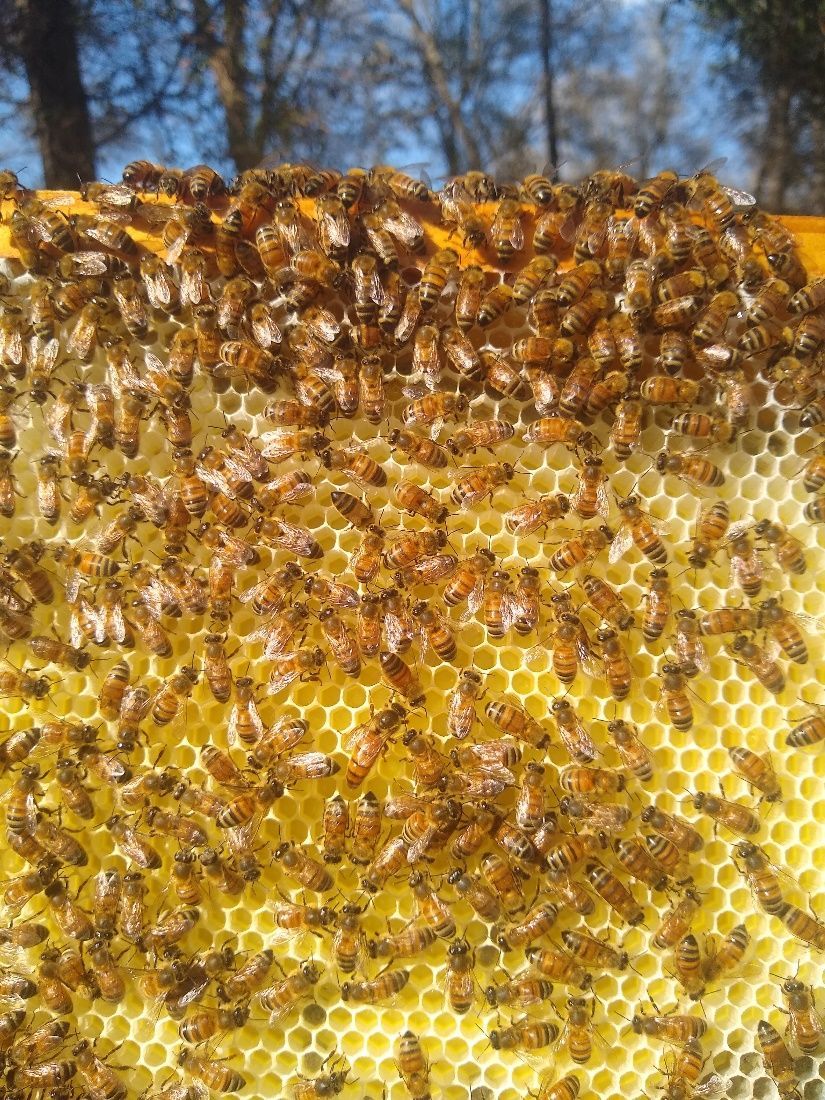
Credit:
Return to the Hive

Credit: Mike Bentley, UF/IFAS
- What are the three types of honey bees and their key roles in a colony?
- Why do you think there are more worker bees than any other type of honey bee?
- What are some differences that can help you tell the honey bees apart?
- Why are the drones thrown out of the hive before winter?
Taste the Honey

Credit: monkeybusinessimages, iStock, Getty Images
- What are some different roles that you have at home? At school? On your team?
- What happens if you do not fulfill your role at home? At school? On your team?
- How is working together better than trying to work alone?
Pollen Patties

Credit: Tyler Jones, UF/IFAS Communications
Choose one of your roles at home, at school, or on a team. Are you a big brother or sister? Are you the goalie or team captain? Are you a friend? Think about how well you are doing in your specific role. Who else in the group do you depend on to help you? How are decisions made in this group? How can you do better in your current role? What other roles do you look forward to having someday in other organizations? How are the roles you have now helping prepare you for ones in the future?
Chapter 1.5 Worker Bee Tasks
What’s the Buzz?

Credit: UF/IFAS Honey Bee Research and Extension Laboratory
A honey bee colony is more than thousands of bees just living together in a large group. The colony is considered a superorganism. As a superorganism, each honey bee in the colony is similar to a cell inside the human body. A single cell could never survive on its own, but when many cells work together, they make up different parts and organs of the human body. As each part or organ does its special job and works with other organs, the body can do wonderful things, like run, climb trees, grow, and breathe. Honey bee colonies are the same. Each bee in the colony has a specific job, and working together, they keep the colony alive and strong.
The Bee’s Knees
Thermoregulation
Honey bee colonies have the amazing ability to control the temperature of their hive through a process called thermoregulation. While honey bees as individuals are cold-blooded, meaning they cannot control their own body heat, the colony as a whole is warm-blooded and produces its own heat. Honey bees prefer their homes to be a toasty 93–95 degrees Fahrenheit. If the temperature drops below this range, the worker bees will cluster around the queen and brood. Then they will shiver their wing muscles and together produce heat to keep the colony warm. This is how honey bee colonies can survive winter even in freezing weather conditions.
If the colony gets too hot during the warmer months, workers will use water droplets to cool the hive. Workers will forage for water and deposit tiny droplets throughout the inside of the hive. Then, they fan their wings at the entrance of the hive (Figure 2), causing the droplets to evaporate, which has a cooling effect that lowers the hive temperature. This process is similar to when you sweat: when water evaporates from your skin, it cools your body.

Credit: Mike Bentley, UF/IFAS
From the moment they crawl out from their brood cells, adult female honey bees begin to work. They will change jobs or tasks as they get older and continue working until the end of their lives. In general, worker bees begin working on the center of the frame where they were born and slowly move toward the hive entrance as they get older. Normally, the order of the tasks follows a pattern as they age, but every worker does not always do every job in the hive.
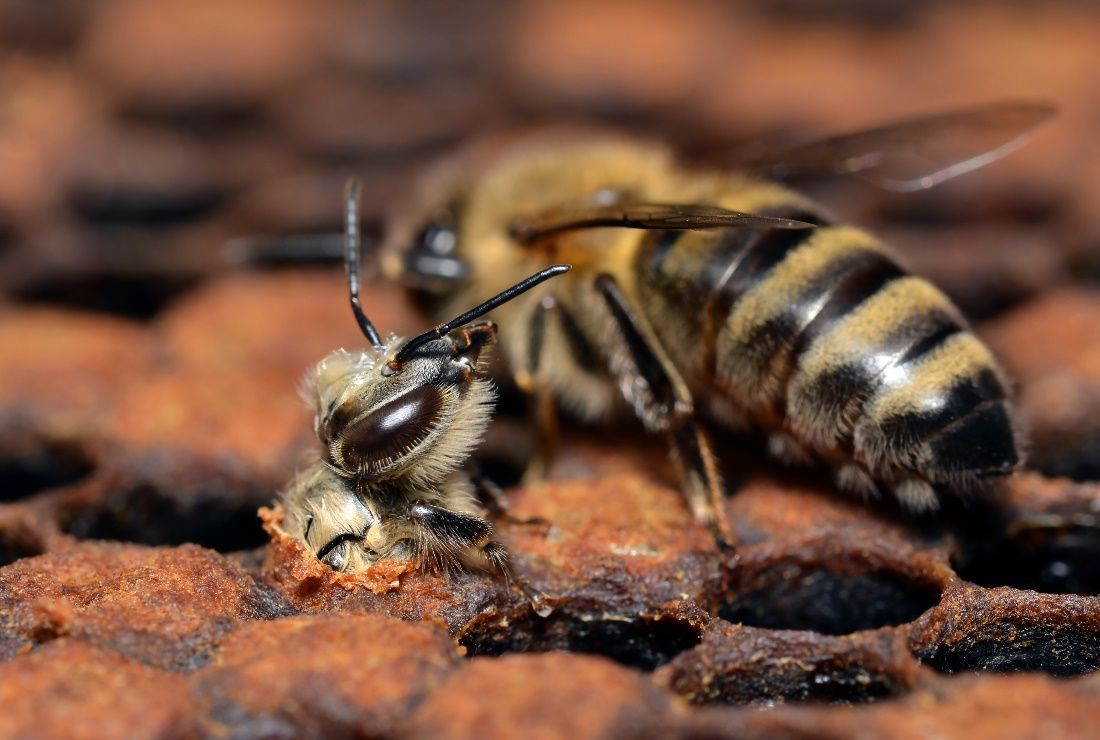
Credit: Mike Bentley, UF/IFAS
Worker honey bees do not take orders from the queen. Instead, the workers decide what tasks need to be done and then do them. Tasks can also change to meet the unique needs of the colony, such as when an emergency arises. For example, if there is a sudden heavy rainstorm that kills all the foraging bees at once, younger workers will move up to the foraging tasks earlier in their lives. Because of this flexibility, honey bee colonies can take care of themselves.
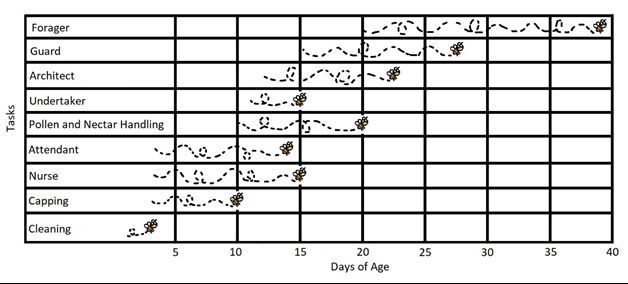
Credit: Emily Helton, UF/IFAS Honey Bee Research and Extension Laboratory
Foraging for Nectar
Activity #1—Worker Bee Charades
Each worker bee has an important task to do in the hive and eventually outside the hive. Below are short descriptions of each task and the approximate age the worker bees are when they perform them. This is a two-part activity. You have a task to do at home (see Step 1) so that you can play Worker Bee Charades with your group the next time you meet (see Steps 2–4).
Step 1. (Done at home) Read the different task descriptions for worker bees (found after the game instructions). Think of a few actions to act out that would give clues for each task. There is space for you to write your action ideas below each description here in your book. If you have never played Charades, it is a word-guessing game. One person acts out a word or phrase, while the others in the group guess the word being acted out. You are not allowed to say any words while acting out the worker bee tasks, so get creative with your actions. Ask your parent or guardian if you need help with ideas.
Step 2. Before your group meets, have your group leader print the name of each worker bee task listed below on small pieces of paper, fold them up, and put them into a container.
Step 3. One at a time, pull a task description out of the container; do not tell each other which one you have. Look at your list of descriptions and the actions you thought of and decide how to act out the task you chose.
Step 4. Then play Worker Bee Charades with your group of friends. Take turns in front of the group, and without speaking, act out the worker bee task you chose. Let the group guess which one you have.

Credit: Mike Bentley, UF/IFAS
Cell Cleaners (1–3 days old)
- Are still developing and cannot yet sting or fly.
- Clean out the cell from which they just hatched so the queen can lay another egg in it.
- Use their mandibles or jaws and forelegs to remove remaining brood food, waste, and leftover wax capping.
- Repeat this in other nearby cells.
Worker Bee Charade actions
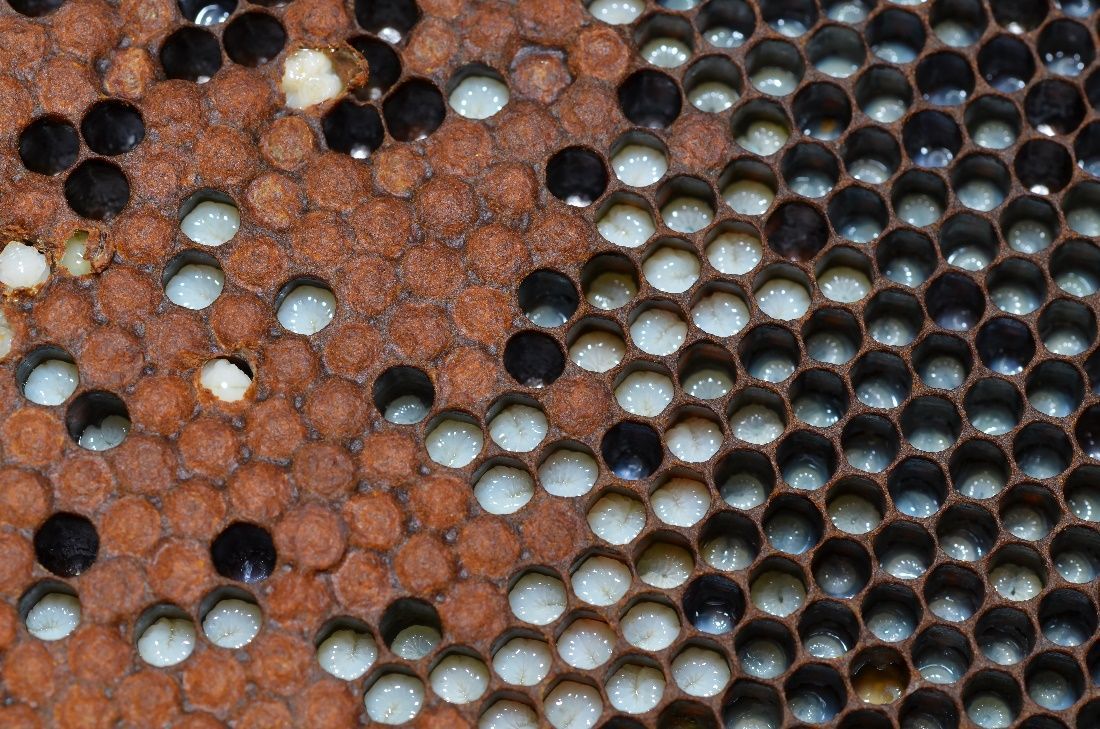
Credit: Mike Bentley, UF/IFAS
Cell Cappers (3–10 days old)
- Secrete wax sheets from special wax glands on their abdomens.
- Work and shape these sheets in their mandibles or jaws.
- Use the wax to cap or cover the cells of larva when they are ready to transform into pupae.
- Use the wax to cap or cover cells that are full of ripe honey so it can be saved for later.
Worker Bee Charade actions:
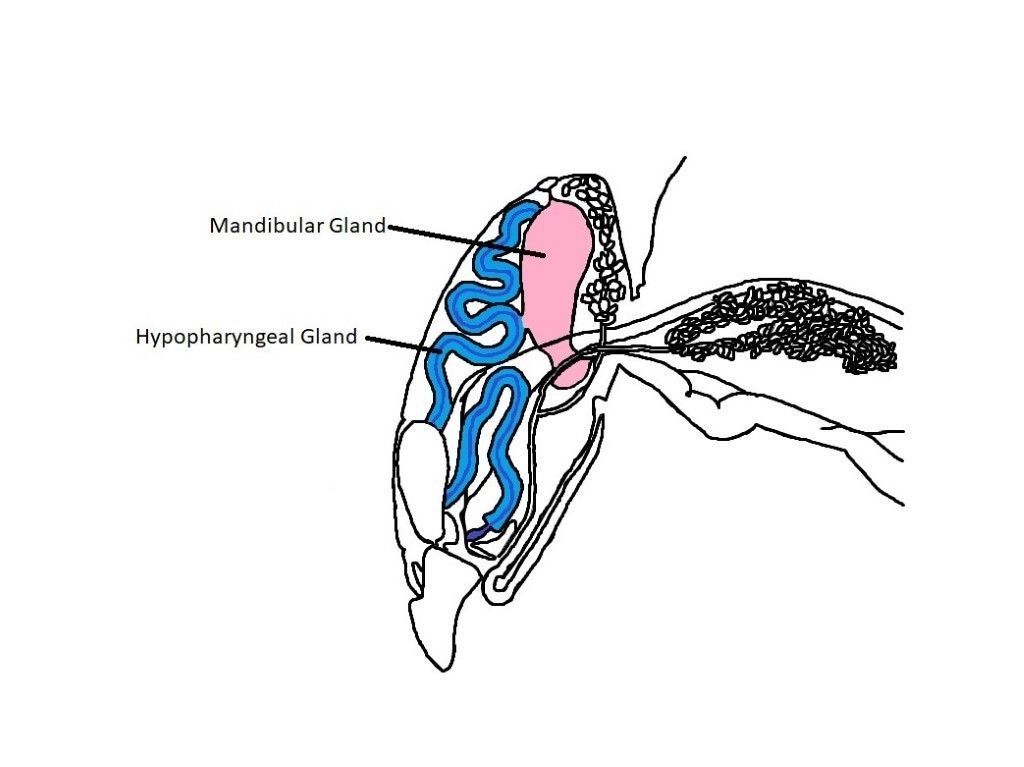
Credit: Emily Helton, UF/IFAS Honey Bee Research and Extension Laboratory
Nurse Bees (3–15 days old)
- Allow hypopharyngeal and mandibular glands to grow and develop in their mouths to make royal jelly.
- Make and feed royal jelly to worker and drone larvae for their first three days after hatching from an egg.
- Make and feed bee bread to worker and drone larvae.
- Visit and care for each larva over 5,000 times and feed them over 1,000 times before the cell is capped or covered with wax.
Worker Bee Charade actions:

Credit: Mike Bentley, UF/IFAS
Queen Attendants (3–14 days old)
- Encircle the queen to feed her royal jelly throughout her life by a mouth-to-mouth process called trophallaxis.
- Encircle the queen to assist with grooming and removing waste matter from her.
- Pick up the queen's pheromone and spread it around the hive so the other worker bees know their queen is alive and well.
Worker Bee Charade actions:

Credit: Mike Bentley, UF/IFAS
Pollen and Nectar Handlers (10–20 days old)
- Wait near the entrance of the hive to accept regurgitated nectar collected by other bees.
- Find a clean cell into which they can add nectar.
- Blow bubbles with the nectar and begin the dehydrating or drying process that turns nectar into honey.
- Pollen is taken off the corbiculae, or pollen baskets, and put into a clean cell by the same bee that collected it.
- Another food handler will then mix the fresh pollen with honey and saliva. This mixture is known as bee bread and is used to feed the brood in the hive.
Worker Bee Charade actions:
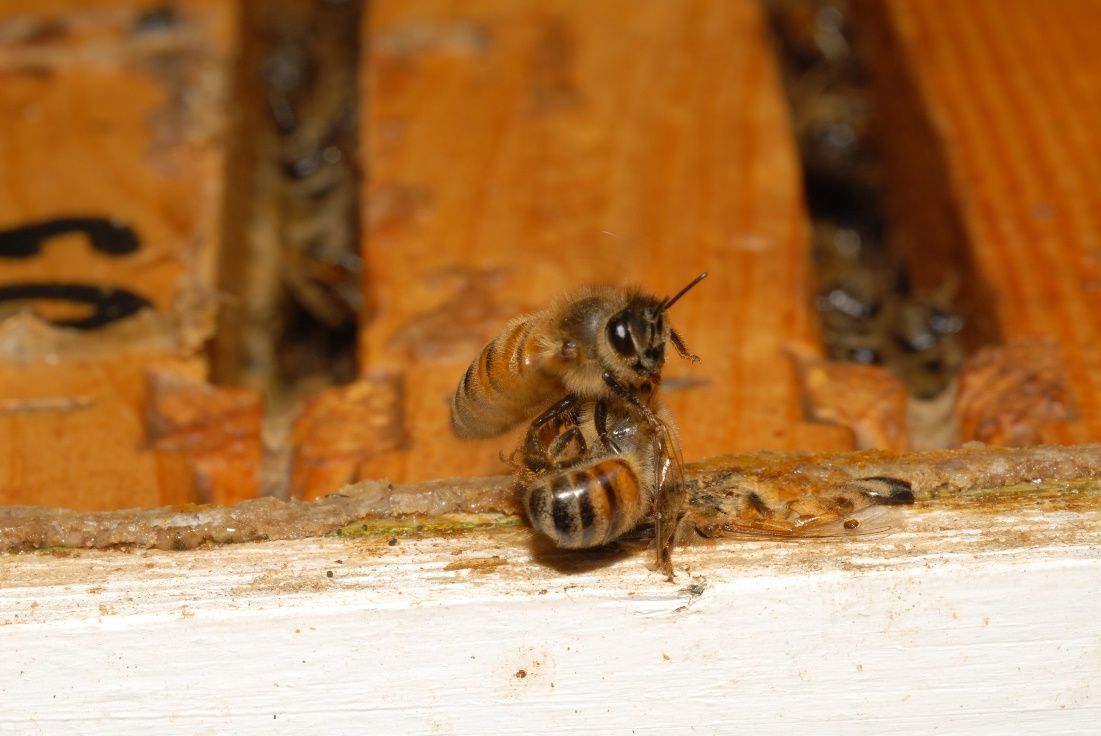
Credit: UF/IFAS Honey Bee Research and Extension Laboratory
Undertakers (11–15 days old)
- Pick up waste matter and debris and take it out of the hive. This includes dead bees, brood, and pests, which could otherwise spread disease.
Worker Bee Charade actions:

Credit: UF/IFAS Honey Bee Research and Extension Laboratory
Architects (12–23 days old)
- Use their mandibles or jaws to soften and shape wax scales that come from the wax glands on their abdomen.
- Build the wax comb on the frames.
- Form the cells of the comb. These hexagonal cells are used for brood development and food storage.
Worker Bee Charade actions:

Credit: Mike Bentley, UF/IFAS
Guard Bees (15–28 days old)
- Protect the colony from predators including wasps, bears, skunks, and other honey bees from neighboring colonies.
- Sit at the hive entrance on their back four legs, holding their front two legs in the air. They use their front two legs and antennae to judge everything entering colony as either friend or enemy.
- Are willing to give their lives to protect the colony.
- Are armed with barbed stingers that inject venom into their victim. When a worker stings, the stinger is pulled from her body along with other vital organs which causes her to die.
Worker Bee Charade actions:

Credit: Mike Bentley, UF/IFAS
Foragers (20–40 days old)
- Forage for or collect materials outside the hive that are necessary for colony survival. There are four things that foragers collect: pollen and nectar as food sources, water to cool the hive, and plant sap or resin, which is used to make propolis. Propolis is a sticky, glue-like substance that has many uses in the hive, such as sealing up cracks and crevices in the hive.
- Have the final duty of this hardworking group. Worker bees remain foragers until they die somewhere between 6 and 8 weeks of age.
Worker Bee Charade actions:
Activity #2—Nectar Foraging Race
Now that you know all the different jobs of the worker bees, let us focus more on the foragers. Honey bees collect nectar from flowers, then take it back to their hive, a behavior we call “foraging.” In the hive, worker bees turn that nectar into honey to be stored for later use. Why do bees need so much honey, you might ask? They need honey to feed the brood and all the other workers and drones in the hive. It takes a lot of bees to produce that much honey. In fact, one honey bee will only make 1/12 of a teaspoon in its entire life!
In this relay-race activity, you will mimic how honey bees search for nectar sources and work with the other foragers to collect enough nectar for your colony. Work with your group leader to gather the supplies and set up the game.
Step 1. Gather the following supplies for the activity:
- 4 disposable cups for each team
- 1 disposable bowl for each team
- water
- food coloring
- plastic syringe, small sponge, or medicine dropper
- markers
Step 2. Fill four cups with water for each team. Be sure to fill them to various levels, including a cup that is almost empty and a cup that is almost full to represent different amounts of “nectar” in different flowers.

Credit: Emily Helton, UF/IFAS Honey Bee Research and Extension Laboratory.
Step 3. Use the food coloring to change the water in the cups. Use a different color for each team.

Credit: Emily Helton, UF/IFAS Honey Bee Research and Extension Laboratory.
Step 4. Each team will have one bowl at the starting line marked with their team color. It will also be marked with a water fill line.

Credit: Emily Helton, UF/IFAS Honey Bee Research and Extension Laboratory
Step 5. Take the cups of colored water and have your leader spread them out or hide them around the classroom or in the yard. These will be your nectar sources. Some can be close to the starting line, and some can be far away.
Step 6. Split your group into teams. One person from each team will be given a plastic syringe/sponge/medicine dropper (something to collect nectar).
Step 7. While the first person from each team runs out to collect nectar from the cups, the rest of their team is waiting at the starting line.
Step 8. Once that person returns to the starting line and squeezes the water into the bowl, they pass the plastic syringe/sponge/medicine dropper to the next player in line.
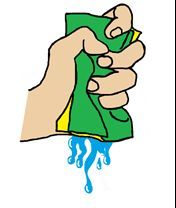
Credit: undefined
Step 9. The goal is to fill your team’s bowl with your team’s colored water to the fill line before any of the other teams. Have fun!
Return to the Hive

Credit: UF/IFAS Communications
- Name four things that honey bees forage for outside of the hive.
- What do the honey bees do with the pollen and nectar once they bring it into the hive?
- List the nine age-related tasks of a worker bee.
Taste the Honey

Credit: UF/IFAS Communications
- What are some different ways that humans obtain food?
- How is a human diet different from that of a honey bee?
- Think of your family at home. Do you always have to be told to wash the dishes, or make your bed, or feed the dog? Do you ever do chores without being asked? Why or why not?
- What are some jobs you can do now that someone younger than you cannot do? What are some jobs you cannot do now but can do when you get older?
Pollen Patties
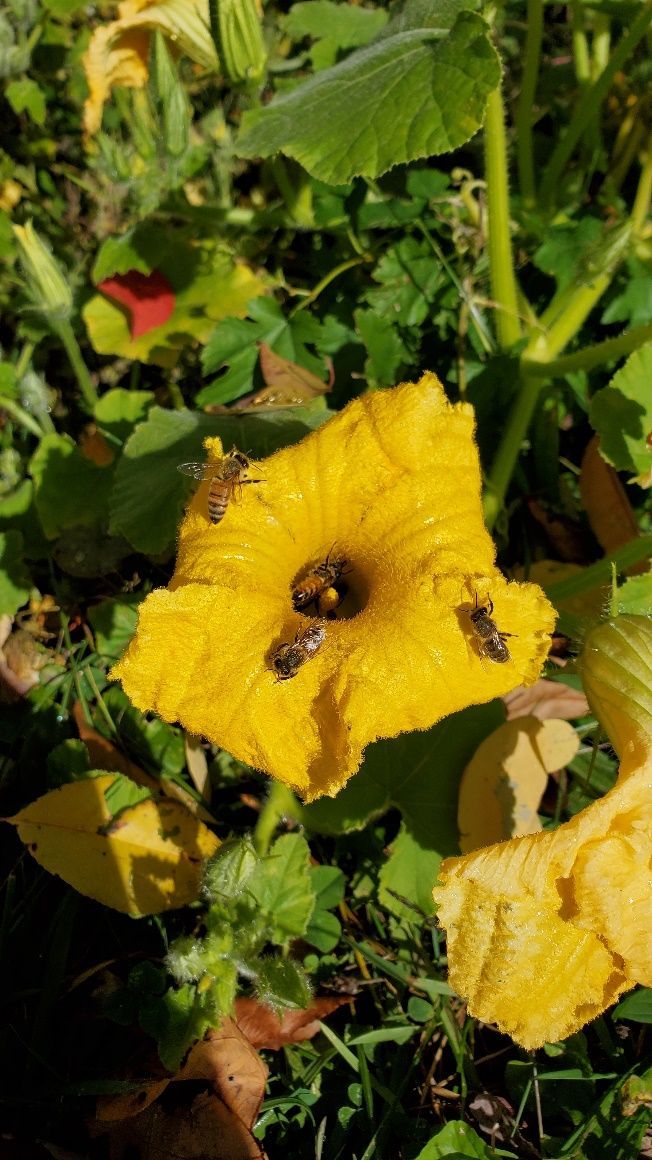
Credit: Kristen Lang—used with permission
Visit a nearby flower or vegetable garden during the day and see if you can spot any foraging honey bees. Make sure to not confuse them with other insects that look like honey bees. Count how many you see. Try to keep track of one bee for a minute. How many flowers does she visit? Can you see any pollen on the back of her legs?
Chapter 1.6 Honey Bee Communication

Credit: UF/IFAS Honey Bee Research and Extension Laboratory
What’s the Buzz?
There are different species of bees that live as either solitary insects, on their own, or social insects, in a group. Honey bees are social insects that have developed interesting methods of communicating with each other. The two methods best understood by humans involve the use of pheromones and dancing.
Pheromones are chemical substances that have a special smell. Only the same kind of insect or animal that gives off the pheromone can smell it. Honey bees make and give off these special smells to signal or communicate with other bees in their colony. They pick up these pheromone signals from each other using receptors on their antennae. Each queen and colony have their very own unique pheromone. The colony’s pheromone helps workers identify and fly into their correct hive after they have been out foraging. Pheromones are also used to warn each other of danger and let the whole colony know how the queen is doing.
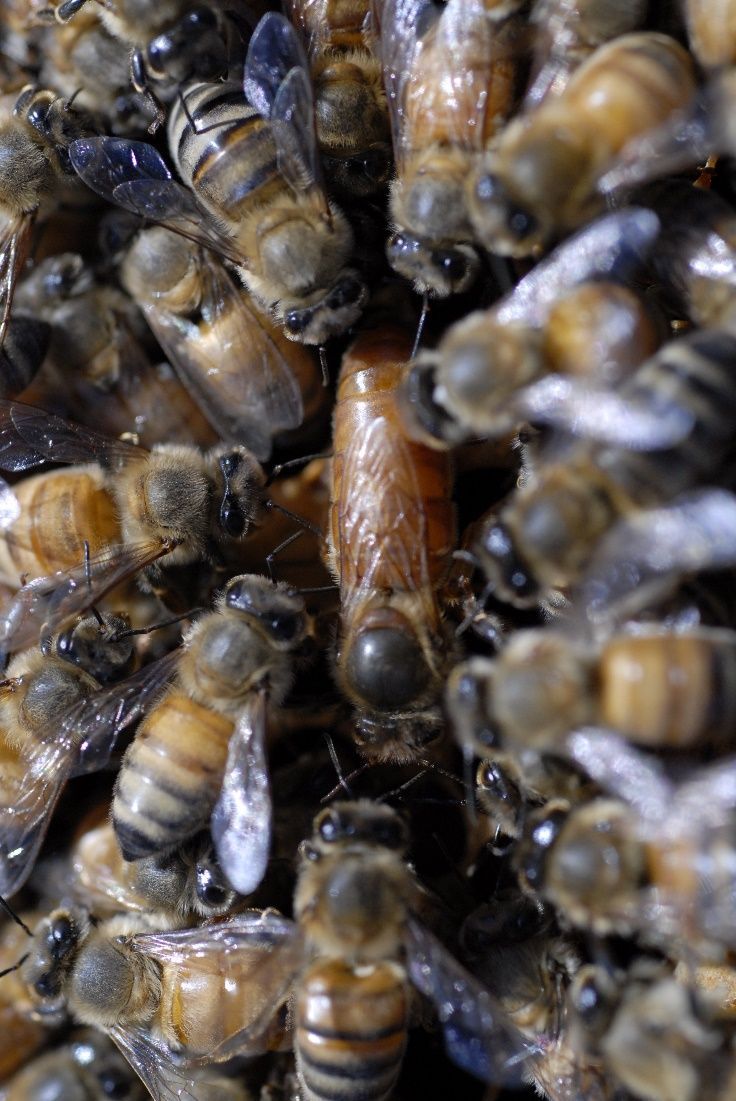
Credit: UF/IFAS Honey Bee Research and Extension Laboratory
The Dance Language
Another form of honey bee communication is the use of dance language. They use different dances to communicate different things. One such dance is used by foragers who have found an excellent floral source of pollen or nectar. They will come back to the hive and convince their foraging sisters to visit the site as well. In a process called the waggle dance, workers can communicate the distance, direction, taste, and value of the resource they have found. The dance looks like the pattern of a figure eight (Figure 4).

Credit: Michelle Weschler, UF/IFAS Honey Bee Research and Extension Laboratory
First, a dancing bee makes a zigzagging (waggle) motion forward followed by a turn to the right to circle back to her starting location. She then makes the zigzagging motion again, but this time turns to the left to circle back to the beginning. The length of the waggle part of the dance shows the distance a bee will have to fly to get to the floral source. How fast she waggles, as well as the number of times she completes the dance cycle, shows the quality or how good of a resource she has found.
The dancers communicate the direction of a floral source using the location of the sun. Honey bees understand that if a source is found in the same direction as the sun, the dancing bee will waggle on the frame in a straight up direction towards the top of the hive. If we compare this to the face of a clock, straight up on the frame is the 12 o’clock position (Figure 5).

Credit: Bori Bennett, UF/IFAS Honey Bee Research and Extension Laboratory
If the floral source is in a different direction from the sun, the bee will adjust the angle of her waggle to show that difference. Using figures 6 and 7 below, think of the numbers on the face of a clock and the direction of the sun. Whatever the direction of the sun is, it will always be the 12 o’clock position on the clock face. This may mean you have to turn the clock face to line up the sun with the 12 o’clock position (Figure 6). The colony is located at the center of the clock. The minute hand on the clock points in the direction of the source of pollen and nectar, which is shown pointing to the 6 o’clock position (Figures 6 and 7). The direction the minute hand is pointing is the direction the bee will waggle on the frame. When looking at a bee frame, the top of the frame is the 12 o’clock position (Figure 5), so the dancing bee would waggle straight down on the frame for this example (Figure 8).

Credit: Michelle Weschler, UF/IFAS Honey Bee Research and Extension Laboratory

Credit: Michelle Weschler, UF/IFAS Honey Bee Research and Extension Laboratory
The dancing bee also shares nectar of the desired floral source to the other foragers to taste what they are going to collect. When the bees watching the dance leave the hive to forage, they now know about how far and which direction to fly to find the site of the floral source.

Credit: Bori Bennett, UF/IFAS Honey Bee Research and Extension Laboratory
Communicating the Swarm
Both dancing and pheromones are used to communicate during the swarming process. A swarm is when a colony reproduces itself. Part of the colony and queen will leave (or swarm) the parent hive. First, scout bees from the swarm will travel in all directions to find a new nest. If a scout finds a site that she considers suitable for a new home, she will return to the swarm cluster and perform a waggle dance. This dance, very similar to the dance for floral resources, shows the other workers the direction, distance, and quality of this potential site. Several scouts will dance to describe the different sites they found. This new home can be any suitable cavity or hollow space with a small entrance and is preferably off the ground. Then they vote to decide which site will be the best. Colonies begin swarming in early spring. If there are enough resources, they will continue to swarm as necessary all through the summer.

Credit: UF/IFAS Honey Bee Research and Extension Laboratory

Credit: Megan Hammond, UF/IFAS Honey Bee Research and Extension Laboratory

Credit: Megan Hammond, UF/IFAS Honey Bee Research and Extension Laboratory
The Bee’s Knees

Credit: Zoe D. Depecol, UF/IFAS Honey Bee Research and Extension Laboratory
Swarming
Honey bees reproduce to make more bees at two levels. The first is at an individual level when drones mate with the queen and she lays eggs, one in each cell. The second is at a colony level through a process called swarming. The hive can become too crowded as colony population grows in the spring and there are not enough open brood cells for the queen to lay eggs. At this point, the colony begins the swarming process. Workers start by trying to raise new queens. When the queens hatch out of their cells, the strongest queen will replace the previous, or mother, queen that left with the swarm.

Credit: Geena Hill, UF/IFAS Honey Bee Research and Extension Laboratory
To prepare for swarming, the mother queen is put on a diet and is made to exercise so she will be light enough to fly to a new nest location. Once the queen is ready, about 60% of the colony’s workers will fill their stomachs with honey and follow her out of the hive. These swarming workers will first find a location nearby, often a tree branch or fence post (Figure 14) on which they can cluster around and protect the queen.
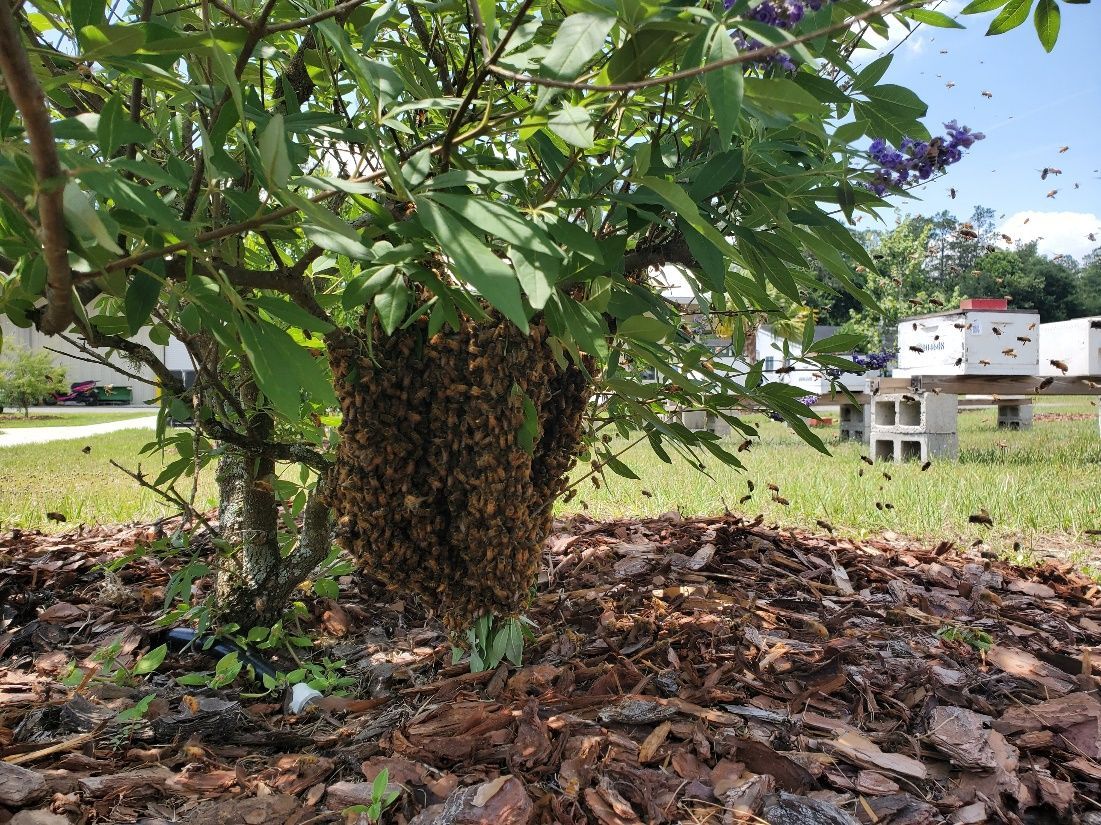
Credit: Rebecca Knox-Kenney, UF/IFAS Honey Bee Research and Extension Laboratory
Once the new nest location is found, the clustered workers and queen will leave behind the new queen, the remaining 40% of the workers, all the food stores, and the brood in the parent colony. The swarmed bees will start a new colony with only the resources of a labor force and the honey they carry with them. This swarming process results in an original, parent honey bee colony splitting to create two separate functioning colonies. This is reproduction at the colony level.
Foraging for Nectar
Activity #1—Waggle Dance Directions
Imagine you are a foraging worker bee that has found a great floral source and you are trying to give directions to the other workers of where to go to find it when they fly out of the hive. Look at each group of pictures below. Use the direction of the sun, the placement of the flower, and the hive to figure out which direction you would waggle on the honey bee frame to show others the way. Remember to think of the face of the clock and the position of the sun on the clock. Sometimes you will have to turn the face of the clock to line up the 12 o’clock position with the sun before you decide which direction to go. Use a marker to draw an arrow on the frame showing which direction the bee will waggle.
1.

Credit: undefined
2.

Credit: undefined
3.

Credit: undefined
4.

Credit: undefined

Credit: UF/IFAS Honey Bee Research and Extension Laboratory
Activity #2—Mystery Scents Matching
Honey bees do not have a nose with which to smell. Instead they use the receptors on their antennae to detect different scents. Their “sense of smell” is very important to their survival. In the following activity, you will test how keen your sense of smell is to see if you can distinguish and correctly match mystery scents.
Instructions for leader:
Step 1. Gather the following supplies and set everything up before the activity, so only you know which items went into which cup:
- 6–8 highly scented items (two of each, for example: oranges, cinnamon, mints, mustard, pickles, flowers, honey, etc.)
*Make sure you are aware of any allergies in your group.
- disposable cups—2 for each scented item
- aluminum foil
- rubber bands
- toothpick
- answer sheets for each player
- pencils
Step 2. Label one set of cups with numbers and the other set with letters. Numbers and letters will make it easier for youth fill out their answer sheets.
Step 3. Line up the numbered cups on one side of a table, one cup for every scented item you plan on using. Place a scented sample in each cup.
Step 4. Tightly cover each cup with aluminum foil using a rubber band to hold it on. Then use a toothpick to poke several small holes in the top to make smelling the goodies possible, but not seeing them.
Step 5. Repeat the process down the other side of your table with the lettered cups. Mix up the order of the lettered set of cups to make this smelling activity a true challenge! Make sure that when you are done, you have two of each sample (one on each side of the table).

Credit: Megan Hammond, UF/IFAS Honey Bee Research and Extension Laboratory
Your Turn: Time to Play!
Step 1. Grab a pencil and an answer sheet to keep track of your matches, or you can use the answer sheet in your book.
Step 2. Stand on the side of the table where the cups are numbered. Choose a cup and smell the scent through the small holes in the aluminum foil. Guess what food item you think it is and write it on your answer sheet. Do this for each numbered cup.
Step 3. Store those scents away and buzzzzzz your way to the other side of the table to the second set of cups that have letters. Now, see if you can be like a bee and find the matching scents. As you match the scents, record your answers on your answer sheet by writing the letter of the cup of the scent that matches the smell of a numbered cup.
Step 4. Go over your answers with the group and reveal which cups were the matching cups. Count the number of matches you got correct. The person with the highest number of correct matches wins!
Mystery Scents Matching Activity Tracking Sheet

Credit: UF/IFAS Honey Bee Research and Extension Laborator.

Credit: Mike Bentley, UF/IFAS
Activity #3—Scent Trail Activity
In this chapter, you learned about honey bees’ antennae and how sensitive they are to vibrations, pheromones, and other smells. In this activity, you will use only your sense of smell to follow a path like honey bees do when searching for nectar or finding their way back home to the hive.
Step 1. Gather the following supplies for the activity:
- two foods that smell obviously different (example for this activity: peppermint candy and an orange)
- blindfold
- masking tape/spray paint/chalk
Step 2. Create a trail with 90-degree turns on the ground using the material you have. Use paint if you are in the grass, chalk if you are outside on the sidewalk, or masking tape if you are inside on carpet or tile. (You need to be able to make sharp left or right turns; not curves or loops.) See the example below.

Credit: Megan Hammond, UF/IFAS Honey Bee Research and Extension Laboratory
Step 3. This game requires teams of two. One partner is blindfolded while the other leads them through the maze.

Credit: Emily Helton, UF/IFAS Honey Bee Research and Extension Laboratory
Step 4. The blindfolded partner will use their sense of smell to choose whether to turn left or right. In the left hand, the leading partner will have peppermint and in the right hand, an orange. When the leading partner holds up the peppermint to the nose of the follower, they will know make a left turn. When the leading partner holds up the orange to the nose of the follower, they will know to turn right.
Step 5. The only words the leading partner can say are “forward” and “stop.” For added competition, time each other to see how long it takes each person to get to the end.
Return to the Hive
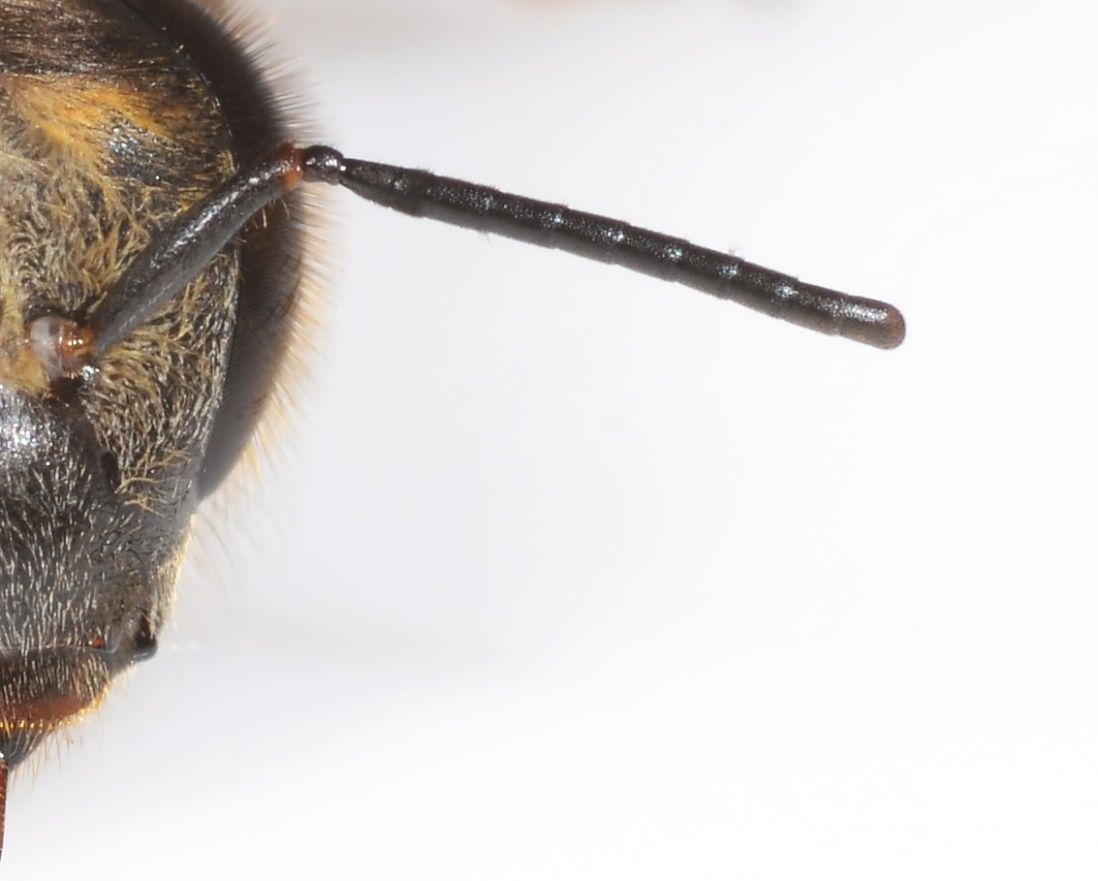
Credit: Mike Bentley, UF/IFAS
- What do we call the special chemical substance that honey bees use to communicate with each other?
- What two examples did you learn about where honey bees use the waggle dance to communicate with the colony?
- What body part do honey bees use to smell?
- Why is a honey bee’s sense of smell so important?
Taste the Honey
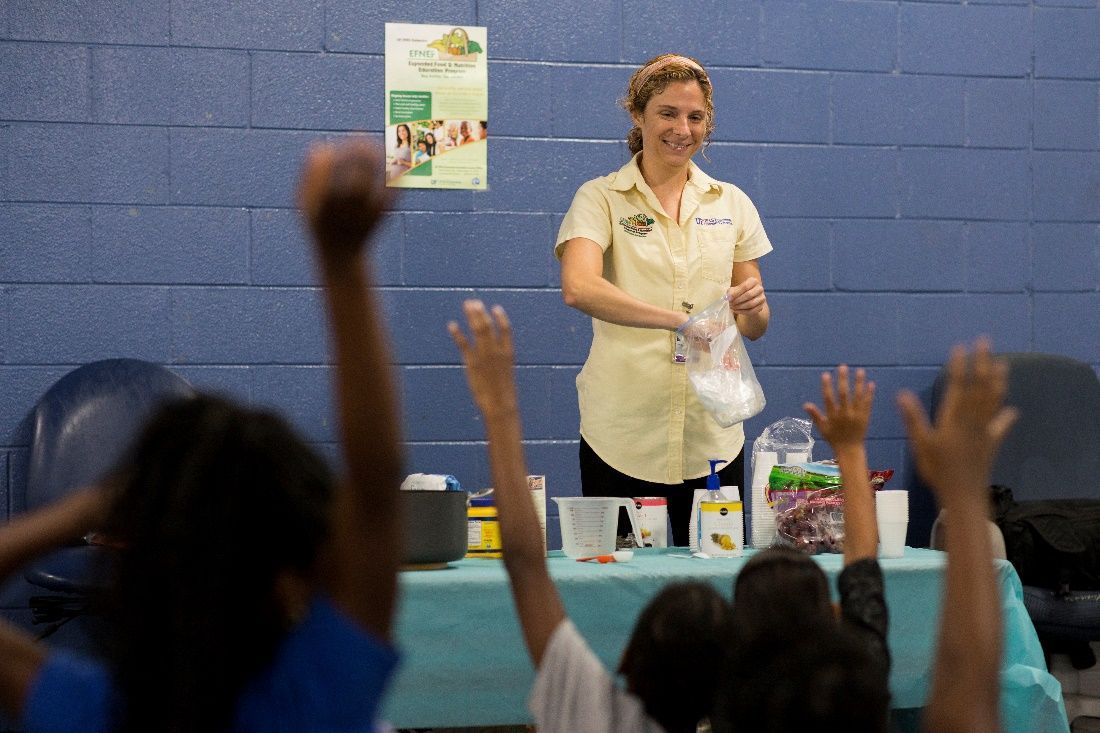
Credit: Tyler Jones, UF/IFAS Communications
- What are some other ways humans communicate without speaking?
- What do you think it would be like if you could not smell anything?
- What other animals do you know of that use a chemical, like pheromones, to warn or communicate with other animals?
Pollen Patties
Dance the Waggle Dance
You have learned how to read the direction of the waggle dance, but can you do the dance? Try it and see if your group can figure out the direction they would need to dance on the honey bee frame to show the direction of the resource. Take turns having one person be the waggle dancer and the rest of the group helping the dancer figure out which way to go. This activity would be best if done outside or in a large room.
Step 1. Collect the following materials for this activity:
- masking tape/spray paint/chalk
- measuring tape
- an object to represent the sun
- an object to represent the pollen or nectar source
- a cardboard box to represent the beehive

Credit: Megan Hammond, UF/IFAS Honey Bee Research and Extension Laboratory
Step 2. Mark off a large enough rectangle that you can dance in it. Use masking tape if you are inside on carpet or tile, paint if you are in the grass, and chalk if you are outside in a parking lot. Mark one long side to represent the top of the frame, and the other long side to represent the bottom of the frame. This will be your honey bee frame on which to dance.

Credit: Megan Hammond, UF/IFAS Honey Bee Research and Extension Laboratory
Step 3. Mark off a large circle on the ground with the same material used in Step 2 to help the group imagine the clock face. Do not write any clock numbers, because items will be moved with each turn and the clock face will have to be adjusted accordingly. Place the box in the middle to represent the hive.

Credit: Megan Hammond, UF/IFAS Honey Bee Research and Extension Laboratory
Step 4. Have the group gather around the circle and watch while the waggle dancer places the objects that will represent the sun and the floral source somewhere on the edges of the circle.

Credit: Megan Hammond, UF/IFAS Honey Bee Research and Extension Laboratory
Step 5. Have the waggle dancer stand in the middle of the circle next to the hive. As a group, determine the 12 o’clock position of the sun. Then determine the direction the minute hand will point to show the angle of the pollen or nectar source from the sun. It helps if they use their arms like clock hands.

Credit: Megan Hammond, UF/IFAS Honey Bee Research and Extension Laboratory
Step 6. Next, have the waggle dancer go onto the rectangle and find their starting place. Remind them to stay inside the frame. Now they dance. First, they make a zigzagging (waggle) motion forward on the frame in the direction the group decided the minute hand would point (reminder: the 12 o’clock position of the sun is always at the top of the frame). The dancer continues with a turn to the right to circle back to their starting place. They then make the zigzagging motion forward again, but this time turn to the left to circle back to the beginning (look back at the diagrams if you forget how this goes). Repeat the dance 2–3 times until the group all understands how this works. Allow each group member a chance to place the objects in different locations and do the waggle dance on the frame.

Credit: Megan Hammond, UF/IFAS Honey Bee Research and Extension Laboratory
Step 7. After everyone understands the waggle motion (this can be a difficult concept to understand), take turns placing the objects within the same circle, but let the dancer figure out the direction to dance on their own. If they get stuck, allow the group to help figure out which direction to dance.
Honey Bee Glossary
Abdomen: The rear body segment of an insect that houses major organs such as the reproductive and digestive organs. A honey bee abdomen also includes the scent and wax glands, venom sac, and stinger.
Adult: An organism or insect that has grown to full size and can reproduce.
Alarm pheromone: A chemical signal used by certain insects to alert colony members when they feel threatened by a predator or other danger.
Antenna: A long, slender organ that comes in a pair on an insect’s head. Together, they are used to gather information about the insect’s surroundings by picking up communication pheromones or scents, and by feeling vibrations. Plural form: antennae
Antenna cleaner: A body part located on the foreleg that is used to groom, clean, and keep debris and litter out of the antennae.
Attendant: Worker bees that encircle the queen bee to feed and clean her. Attendants pick up and spread her unique pheromone around the hive.
Bee bread: A mixture of pollen, nectar, and enzymes made by worker bees. This is used to feed developing brood or as a protein food source for the colony.
Brood: Developing eggs, larvae, and pupae of honey bees that are in the cells of honeycomb.
Capping: A wax covering placed over the top of a comb cell when the growing baby bee has reached the end of the larval stage. It is also placed over cells of ripe honey.
Caste: A group of individuals of the same gender that behave similarly to each other, but differently from another group of their gender. In the case of honey bees there are two castes: workers and queens.
Cell: One of many prepared spaces or smaller chambers, shaped like hexagons, that are made from beeswax. Together the cells compose the comb. Cells are where eggs are laid, larvae and pupae develop, and honey and pollen are stored.
Cocoon: A covering of silk or other material that surrounds pupae for protection during the pupal or third phase of complete metamorphosis.
Colony: A group or community of closely related insects that live and work together as one.
Compound eye: An eye composed of many smaller lenses that break apart a single image into many smaller sections. Compound eyes are found on most insects.
Corbicula: An area on the honey bee’s hind leg that holds pollen and other materials to carry back to the nest. Also called pollen basket.
Drone: A male honey bee. Drones mate with a queen honey bee outside of the hive.
Drone congregation area: A designated area outside the hive where mature drones gather and wait to mate with a queen.
Egg: The first stage of complete metamorphosis. Eggs look like a small grain of rice. It is made of a cover that surrounds nutrients necessary for the embryo, or unborn insect to develop into a larva.
Floral: Flower.
Forage: To search for and collect food sources or other vital resources.
Forelegs: The front pair of legs, located on the thorax, that can have claws for climbing and antenna cleaners.
Forewing: The top or larger wing located on the front of an insect’s thorax. It can be thick, scaly, and transparent.
Guard bee: Worker honey bees that protect the colony from predators. They sit at the entrance of the hive and assess everything that tries to enter as either friend or foe.
Hamuli: A row of tiny hooks that connect the back edge of the forewing (where the hooks are located) to the front edge of the hindwing during insect flight.
Head: The first insect body segment. It contains the sensory organs such as the eyes, mouth parts, and antennae.
Hind legs: The last of three pair of legs on the thorax where the corbicula is located.
Hind wings: The bottom or smaller wing located on an insect’s thorax, usually thin and membranous.
Hive: An artificial structure that serves as a home for a honey bee colony.
Honey: Flower nectar that has been partially dehydrated by worker bees. It has a transparent golden appearance and is sticky and sweet.
Hypopharyngeal glands: A pair of glands in the head of adult worker bees that produce food for brood.
Koschevnikov gland: A gland located near the stinger that produces and releases the alarm pheromone when a honey bee stings its victim.
Larva: At the beginning of the second stage of complete metamorphosis, a wormlike immature honey bee that hatches from the egg. Plural form: larvae
Mandibles: The set of insect mouthparts that act like teeth. In the case of honey bees, they are used for defense, grooming, cutting and shaping wax, and cleaning the hive.
Mandibular gland: A gland found around the mouthparts of insects where pheromones are produced in addition to functioning as the main salivary gland, which aids in predigestion.
Metamorphosis: A process or series of physical changes that an insect goes through to become an adult.
Midlegs: The middle pair of legs located on the thorax and used for stability.
Nasonov pheromone: A pheromone, specific to each colony, that is used to help foraging honey bees find their way back to their own colony even if there are other colonies nearby.
Nectar: A sugary fluid secreted by flowering plants to encourage pollination by insects or other animals. It is collected by honey bees and made into honey.
Nectary: Plant glands located at the base of a flower that produce and secrete a sweetened liquid called nectar.
Nurse bee: A worker bee that cares for and feeds developing brood.
Ocellus: A simple type of insect eye that contains a single lens. Some insects have three ocelli on the top of their head. They allow insects to notice the presence of and changes in the light. Plural form: ocelli
Ovipositor: A body part used to lay eggs that is located at the end of the female insect’s abdomen.
Pheromone: A chemical scent or signal released by an insect, animal, or plant that affects the behavior of other nearby insects, animals, or plants. Many insects use pheromones to attract mates or warn of danger.
Pollen: Tiny, often yellow, powdery grains produced by male flowers or the male organs in a flower. Pollen must be carried by pollinators, wind, or water to female flowers or female organs in a flower for reproduction.
Pollinator: An animal, insect, or human that aids in the movement of pollen from one flower to another flower.
Predator: An animal or insect that receives nourishment by hunting and eating other animals or insects.
Proboscis: A long, soft, straw-like tongue insects use for lapping or sucking.
Propolis: A sticky, glue-like substance that comes from the resin or sap of trees and plants. Honey bees collect it and use it to seal up cracks and crevices in the hive, regulate temperature, and mummify dead pests. Propolis has antimicrobial properties and helps to keep the colony healthy.
Pupa: During the third stage of complete metamorphosis, the insect starts to develop more adult-like features while encased in a cocoon. Plural form: pupae
Queen: Female member of the reproductive caste in social insects. She is the mother to all other members of the colony, and her primary job is to lay eggs.
Queen mandibular pheromone: A unique chemical signal that the queen honey bee gives off to let the workers in the hive know she is alive and well.
Receptors: Sensory organs located on the antennae of insects that allow them to detect sound vibrations as well as pheromones.
Regurgitation: The act of bringing food back up into the mouth after it has been swallowed.
Royal jelly: A thick, white, nutrient-rich liquid secreted by the pharyngeal glands inside worker bees and fed to very young brood and the queen.
Sclerotize: Toward the end of the pupal stage, the production of sclerotin, a special protein, causes the growing insect’s outer body covering to harden into a protective exoskeleton.
Social: One who lives with a group and works cooperatively with companions.
Solitary: One who lives and works alone and has no companions.
Spine: A stiff, sharp, finger-like projection on the midleg. Used to remove pollen from the honey bee’s corbicula or pollen basket.
Stinger: A long, pointed structure, found at the end of the honey bee’s abdomen. It is used to inject venom or poison into its victims
Superorganism: The idea that a colony of social insects is not simply a collection of individuals, but rather a colony that acts and works together as one individual.
Swarming: Honey bee reproduction at the colony level.
Thermoregulation: Process by which honey bees can control or adjust the temperature of the hive.
Thorax: The middle segment of an insect's body.
Trophallaxis: The sharing of food from the mouth of one insect to the mouth of another insect in the same colony.
Undertaker bee: Worker bee that removes waste and debris from the hive, including dead bees, brood, and pests.
Venom: Toxic or poisonous substance made in the cells and injected by one organism into another organism for self-defense or predation.
Venom sac: An organ for venom storage connected to the stinger.
Waggle dance: A movement honey bees use to communicate with each other the distance, direction, taste, and value of a floral source.
Wax: Substance produced in the honey bee's abdomen as tiny scales, which they use to build their comb.
Wax glands: Tiny openings located along the underside of a honey bee's abdomen. These are where tiny wax scales are made.
Worker: Female, nonreproducing honey bees that perform all daily tasks both inside and outside the hive that keep the colony in working order.
Chapter 1 Answer Key
Chapter 1.1 Honey Bee Body Matching Activity #2
The Body: (1) Thorax (2) Abdomen (3) Head
The Head: (1) Mandible (2) Antenna (3) Compound Eyes (4) Ocelli (5) Proboscis
The Legs: (1) Pollen Basket (2) Spine (3) Antennae Cleaner
Special Features: (1) Stinger (2) Hind Wing (3) Hamuli (4) Forewing (5) Wax Glands
Chapter 1.2 Honey Bee Vision Crossword Puzzle Activity #2

Credit: undefined
Chapter 1.3 Honey Bee Life Cycle Word Search Activity #2

Credit: undefined
Chapter 1.4 Honey Bee Colony Sorting Activity #1
Chapter 1.4 Finding the Queen Activity #2

Credit: undefined

Credit: undefined
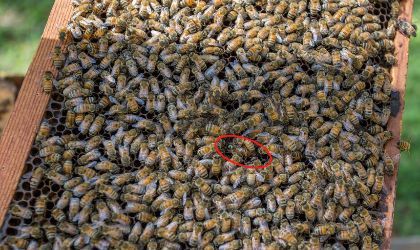
Credit: undefined

Credit: undefined

Credit: undefined

Credit: undefined
Chapter 1.6 Waggle Dance Directions Activity #1

Credit: undefined

Credit: undefined

Credit: undefined
